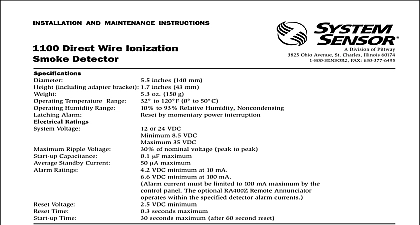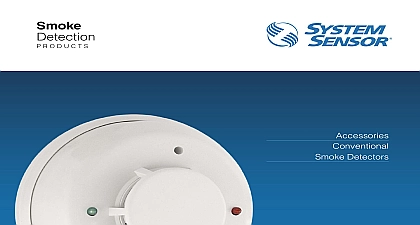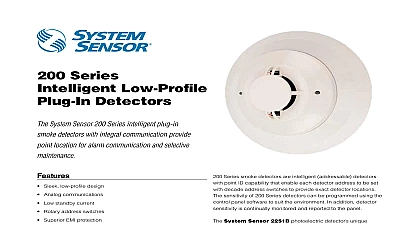System Sensor Proper Use of System Smoke Detectors

File Preview
Click below to download for free
Click below to download for free
File Data
| Name | system-sensor-proper-use-of-system-smoke-detectors-4785923016.pdf |
|---|---|
| Type | |
| Size | 1.02 MB |
| Downloads |
Text Preview
A P P L I C A T I O N S G U I D E Detectors Detectors 2 Systems 9 3 Dos and Don 9 Codes and Standards 3 Detector Applications Placement and Spacing 9 That Apply 3 to Place Detectors 9 and Fire Codes 3 Not To Place Detectors 10 Laboratories 3 for Smoke Detectors 11 Publications 3 Spacing 11 Publications 3 in Air Handling and Air Conditioning Systems 13 Smoke Detector Operation 4 Smoke Detectors Work 4 Smoke Detector Operation 5 Light Scattering Smoke Detector 5 Light Obscuration Smoke Detector 5 Detector Design Considerations 5 in Selecting Detectors 5 Detector Limitations 6 System Layout 6 Supervision 6 B Circuits 6 A Circuits 6 Circuits 7 Zoning Guidelines 7 Safety Functions 7 Detector Installation 7 in Above Ceiling Plenum Areas Including Those Utilized Part of the HVAC System 13 Maintenance and Service of Detectors 13 Inspection Test and Maintenance Practices 13 Techniques 14 to Do About Unwanted Alarms 14 for Unwanted Alarms 14 an Alarm Log 14 of Location or Environment 14 Detector for Dirt Review Maintenance 15 of Other Systems on Alarm System 15 Causes of Unwanted Alarms 15 of Detector Owners and Installers 15 to Get Help if the Source of Unwanted Alarms Cannot be Found 16 of Terms 17 Alarm Log 19 use of early warning fire and smoke detection systems results in significant reduction in fire deaths The sooner a fire is detected the better the out for saving lives This document provides guidance for the proper operation of fire detection systems for those who apply install and maintain them installation and maintenance of smoke detectors prevents unwanted nuisance alarms Occupants can become desensitized when repeated alarms occur In worst case scenarios technicians could disconnect alarms from the system to avoid the unnecessary disruption Either situ negates a detector potential life saving benefit making the proper operation of an early warning fire and smoke detection system indispensable GUIDE SYSTEM SMOKE DETECTORSfirealarmresources com and Fire Codes purpose of this guide is to provide information concerning the proper of smoke detectors used in conjunction with fire alarm sys The guide outlines basic principles that should be considered in the of early warning fire and smoke detection devices It presents characteristics of detectors and environmental factors which aid delay or prevent their operation document presents information for fire protection mechanical and engineers fire service personnel fire alarm designers and install A key element in the effectiveness of smoke detection systems is the version of NFPA 72 for installation and testing of systems Installation comply with all code requirements and directions from Authorities Jurisdiction AHJs AHJ directives always take precedence over codes and exercise final authority over installations and maintenance Code Council Inc International Building Code Fire Code ICBO and SBCCI formed an umbrella organization known as the Code Council ICC to combine their codes into a single set model building and fire codes The ICC International Building Code and Fire Code were first published in 2000 and were adopted by states Laboratories laboratories test smoke detectors control panels and other compo of fire alarm systems to verify conformance with NFPA requirements their own standards Equipment that passes their tests is identified by label and or listing Testing laboratories are also known as Testing Laboratories or NRTL Codes and Standards 1 That Apply publishes standards for the proper application installation and main of automatic smoke detectors The principal codes and standards should be reviewed before specifying or installing automatic smoke are listed below Fire Protection Association NFPA Park MA 02269 9101 publishes standards concerning all phases of fire protection These to automatic smoke detectors 70 National Electrical Code 72 National Fire Alarm Code and Signaling Code 72 covers minimum performance location mounting testing maintenance requirements of automatic fire detectors Many NFPA specific standards are available and should be considered in to NFPA 72 when applicable 90A Standard for the Installation of Air Conditioning Ventilating Systems 90B Installation of Warm Air Heating and Air Conditioning 92B Smoke Control Systems in Malls Atria and Large Areas 90A and 92B provide information for the use of smoke detectors ducts of heating ventilating or air conditioning HVAC systems and control systems 101 Life Safety Code 101 specifies the requirements for smoke detection in both new and buildings depending on the type of occupancy E Algonquin Rd Arlington Heights IL 60005 Laboratories Inc UL LLC Pfingsten Road IL 60062 publishes an annual directory of fire protection equipment which bears UL label The following standards apply to smoke detectors 217 Single and Multiple Station Smoke Alarms 268 Smoke Detectors for Fire Alarm Systems 268A Smoke Detectors for Duct Applications 864 Standard for Control Units for Fire Protective Signaling Systems Approvals Boston Providence Turnpike P


